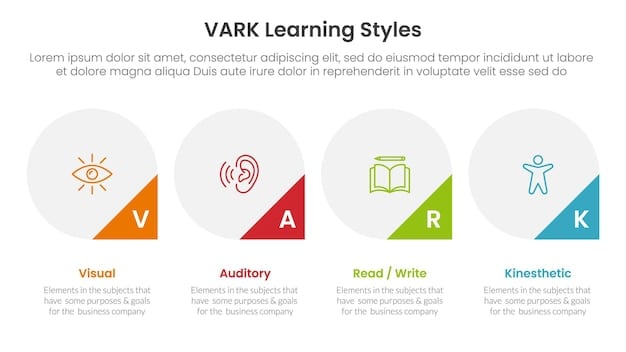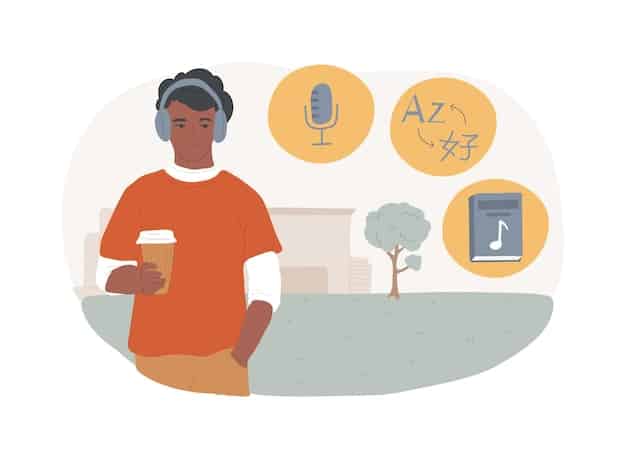Boost Your Memory: Proven Strategies for Every Learning Style

Boost Your Memory: Proven Strategies for Each Learning Style to Retain Information Longer explores tailored techniques for visual, auditory, reading/writing, and kinesthetic learners, enhancing memorization through personalized approaches that suit individual strengths.
Do you ever struggle to remember important details, no matter how hard you try? The secret might not be in working harder, but in working smarter. Understanding and applying the right strategies based on your learning style can boost your memory: proven strategies for each learning style to retain information longer.
Unlock Your Memory Potential: Tailoring Techniques to Learning Styles
Everyone learns differently. Recognizing your dominant learning style is the first step toward unlocking your memory potential. By adapting learning techniques to suit your style, you can retain information more effectively and recall it with greater ease.

Whether you’re a visual learner who benefits from diagrams and images, an auditory learner who thrives on discussions, a reader/writer who prefers notes and text, or a kinesthetic learner who learns best through hands-on experience, understanding these styles empowers you to tailor your approach to learning and remembering.
Identifying Your Dominant Learning Style
Understanding your learning style is crucial for optimizing your memory. Many online quizzes and self-assessment tools can help you discover whether you are primarily a visual, auditory, reading/writing, or kinesthetic learner.
- Visual Learners: Benefit from seeing information presented in charts, graphs, and diagrams.
- Auditory Learners: Learn best by listening to lectures and participating in discussions.
- Reading/Writing Learners: Prefer to learn through written words, taking notes, and creating lists.
- Kinesthetic Learners: Learn by doing, exploring, and using hands-on activities.
Once you’ve identified your learning style, you can start implementing strategies that align with your preferences to enhance memory retention.
In summary, recognizing your dominant learning style—whether visual, auditory, reading/writing, or kinesthetic—is the initial step in enhancing memory retention, as it allows for the customization of learning methodologies that resonate with personal preferences and learning strengths.
Visual Learners: Strategies to See and Remember
Visual learners excel when information is presented in a visual format. They often think in pictures and have a strong sense of color and spatial relationships. Leveraging these strengths is key to improving memory.
To boost memory retention, visual learners should focus on techniques that involve seeing and visualizing the information they need to remember.
Using Mind Maps and Diagrams
Mind maps and diagrams are powerful tools for visual learners. They help organize information in a way that’s easy to understand and remember.
Create mind maps to visually connect ideas and concepts. Use different colors and symbols to make the information more engaging and memorable. Diagrams can also help break down complex topics into simpler, more manageable parts that are easier to visualize.
Visualization Techniques
Visualization is another effective strategy for visual learners. By creating mental images of the information, you can strengthen your memory.
Try turning abstract concepts into vivid mental pictures. For example, if you’re trying to remember a historical event, imagine yourself being there and witnessing it firsthand. The more detailed and imaginative your visualization, the more likely you are to remember the information.
- Create Mental Movies: Imagine the information playing out like a movie in your mind.
- Use Vivid Imagery: Focus on creating bright, colorful, and detailed mental images.
- Associate Images with Information: Link each piece of information to a specific image that’s easy to recall.
Using these strategies will not only help visual learners remember information but also make learning more enjoyable and effective.
In conclusion, visual learners can significantly enhance their memory retention by utilizing visual aids such as mind maps and diagrams, as well as employing visualization techniques that transform abstract concepts into vivid and easily recallable mental images.
Auditory Learners: Strategies to Hear and Remember
Auditory learners thrive when information is presented through sound. They learn best by listening, discussing, and verbalizing concepts. To enhance memory, auditory learners should focus on techniques that involve hearing and speaking.
Utilizing strategies aligned with their auditory strengths can drastically improve their ability to retain and recall information.

Recording Lectures and Discussions
Recording lectures and discussions is an excellent way for auditory learners to reinforce their understanding. The ability to replay and listen to the material multiple times can significantly improve memory.
Listen to recordings while commuting, exercising, or doing chores. This allows you to review the information without needing dedicated study time. Make sure to take notes while listening to identify key points and areas that need further clarification.
Verbalizing and Teaching
Verbalizing and teaching concepts to others is another powerful technique for auditory learners. Explaining information out loud helps solidify your understanding and reinforces memory.
- Study Groups: Participate in study groups where you can discuss and explain concepts to others.
- Teach Others: Offer to tutor or explain concepts to friends or family members.
- Read Aloud: Read notes and textbook passages aloud to engage your auditory senses.
By verbalizing and teaching, auditory learners can convert passive listening into active learning, leading to improved memory retention.
To sum up, auditory learners can greatly enhance their memory by recording and replaying lectures and discussions, as well as actively verbalizing and teaching concepts to others, which transforms passive listening into an engaging learning experience.
Reading/Writing Learners: Strategies to Read, Write, and Remember
Reading/writing learners prefer to learn through written words. They excel at taking notes, reading textbooks, and writing summaries. These learners can boost their memory by focusing on strategies that involve reading and writing.
Customizing memory-boosting techniques to align with their reading and writing inclinations can result in marked improvements in learning efficiencies.
Note-Taking and Summarizing
Taking detailed notes during lectures and while reading is crucial for reading/writing learners. The act of writing helps them process and retain information more effectively.
Summarize key points in your own words. This reinforces your understanding and provides a valuable resource for review. Use different colors and headings to organize your notes and make them easier to navigate during future study sessions.
Creating Flashcards and Outlines
Creating flashcards and outlines is another effective strategy for reading/writing learners. Flashcards are useful for memorizing facts and definitions, while outlines help organize complex information in a structured format.
Write questions on one side of the flashcard and answers on the other. Use these flashcards for self-testing or with a study partner. Outlines can help you break down large topics into manageable sections, making it easier to understand and remember the material.
- Detailed Notes: Take comprehensive notes during lectures and readings.
- Summarization: Summarize key concepts in your own words.
- Flashcards: Create and use flashcards for quick recall of facts and definitions.
In short, reading/writing learners can optimize memory through detailed note-taking, summarizing key concepts, and creating flashcards and outlines, enhancing comprehension and retention.
Kinesthetic Learners: Strategies to Do and Remember
Kinesthetic learners, also known as tactile learners, learn best through physical activity and hands-on experiences. They benefit from movement, exploration, and practical application. To enhance memory, kinesthetic learners should focus on techniques that involve doing and touching.
By aligning memory-boosting strategies with their natural inclination toward physical engagement, kinesthetic learners can significantly improve their information retention capabilities.
Hands-On Activities and Experiments
Engaging in hands-on activities and experiments is an excellent way for kinesthetic learners to reinforce their understanding. The physical involvement helps them process and remember information more effectively.
Conduct experiments to illustrate scientific principles, build models to understand architectural concepts, or visit museums and historical sites to experience history firsthand. The more you actively engage with the material, the better you’ll remember it.
Role-Playing and Simulations
Role-playing and simulations are another effective strategy for kinesthetic learners. These activities allow you to physically embody and interact with the information you’re learning.
- Act Out Concepts: Physically demonstrate or act out concepts to understand them better.
- Use Manipulatives: Use physical objects to represent abstract ideas.
- Take Breaks with Movement: Incorporate physical activity into study breaks to stay focused and energized.
Role-playing historical events, simulating business scenarios, or using building blocks to understand math concepts can greatly enhance memory retention for kinesthetic learners.
In conclusion, kinesthetic learners benefit significantly from hands-on activities and experiments, as well as role-playing and simulations, enhancing memory retention through active physical engagement with the material.
Creating a Multi-Sensory Learning Environment
While identifying your primary learning style is helpful, creating a multi-sensory learning environment can further enhance your memory. By engaging multiple senses—sight, sound, touch, and movement—you can create richer and more memorable learning experiences.
Integrating strategies that cater to different senses can enrich the learning process, making it more effective and memorable.
Combining Visual, Auditory, and Kinesthetic Techniques
Try combining techniques from different learning styles to create a comprehensive learning experience. For example, a visual learner could create a mind map (visual), explain it out loud (auditory), and then build a physical model to represent the concepts (kinesthetic).
An auditory learner could record a lecture (auditory), take notes while listening (reading/writing), and then act out the key points (kinesthetic). By using multiple senses, you can strengthen your memory and improve your understanding of the material.
- Visual Aids with Audio: Use visual aids, such as diagrams, and explain them aloud.
- Hands-On Note-Taking: Take notes using colorful pens and physically manipulate the notes to organize them.
- Movement Breaks: Incorporate physical activity during study breaks to refresh your mind and body.
This multi-faceted approach caters to different cognitive processes, enhancing memory retention and understanding.
In brief, by combining visual, auditory, and kinesthetic techniques, individuals can create a holistic and comprehensive learning experience that leverages multiple senses, ultimately enhancing memory and understanding.
Memory Enhancement Techniques Beyond Learning Styles
While understanding your learning style is valuable, there are other memory enhancement techniques that can benefit all learners, regardless of their preferred style. These techniques focus on improving memory processes, such as encoding, storage, and retrieval.
Using these universal techniques alongside style-specific approaches can offer a well-rounded strategy for boosting memory capabilities.
Spaced Repetition and Active Recall
Spaced repetition involves reviewing information at increasing intervals over time. This technique takes advantage of the spacing effect, which shows that memory is better when learning is spread out over time rather than crammed into a single session.
Active recall involves trying to retrieve information from memory without looking at your notes or textbook. This technique strengthens the neural pathways associated with the information, making it easier to remember in the future.
- Use Flashcards: Regularly review flashcards, spacing out the intervals between reviews.
- Self-Testing: Test yourself regularly without looking at your notes.
- Teach Others: Explaining concepts to others forces you to actively recall the information.
By incorporating spaced repetition and active recall in your study, you enhance memory through regular mental work.
In conclusion, both spaced repetition and active recall are valuable memory enhancement techniques that benefit all learners, improving memory encoding, storage, and retrieval through strategic review and active mental engagement.
| Key Point | Brief Description |
|---|---|
| 🎨 Visual Learners | Use mind maps, diagrams, and visualization techniques. |
| 🎧 Auditory Learners | Record lectures, discuss, and teach concepts. |
| ✍️ Reading/Writing Learners | Take notes, summarize, and create flashcards. |
| 🖐️ Kinesthetic Learners | Engage in hands-on activities and role-playing. |
Frequently Asked Questions (FAQs)
▼
You can identify your learning style by taking online questionnaires or reflecting on how you learn best. Do you prefer visual aids, listening to lectures, reading, or hands-on activities?
▼
Many people have a blend of learning styles. Focus on the techniques that work best for you, regardless of the specific category. Combining strategies caters to various cognitive processes.
▼
Understanding your learning style allows you to tailor your study methods, making learning more efficient and enjoyable. It leads to better comprehension and retention of information.
▼
Yes, memory enhancement techniques such as spaced repetition and active recall can benefit all learners. Incorporating these strategies into your study routine can significantly improve memory.
▼
Combine visual, auditory, and kinesthetic techniques. Use visual aids while explaining concepts aloud, take notes by hand, and incorporate movement breaks during your study sessions.
Conclusion
By understanding your unique learning style and incorporating targeted strategies, you can significantly enhance your memory and learning abilities. Whether you’re a visual, auditory, reading/writing, or kinesthetic learner, there are proven techniques to help you retain information longer and achieve academic success.



